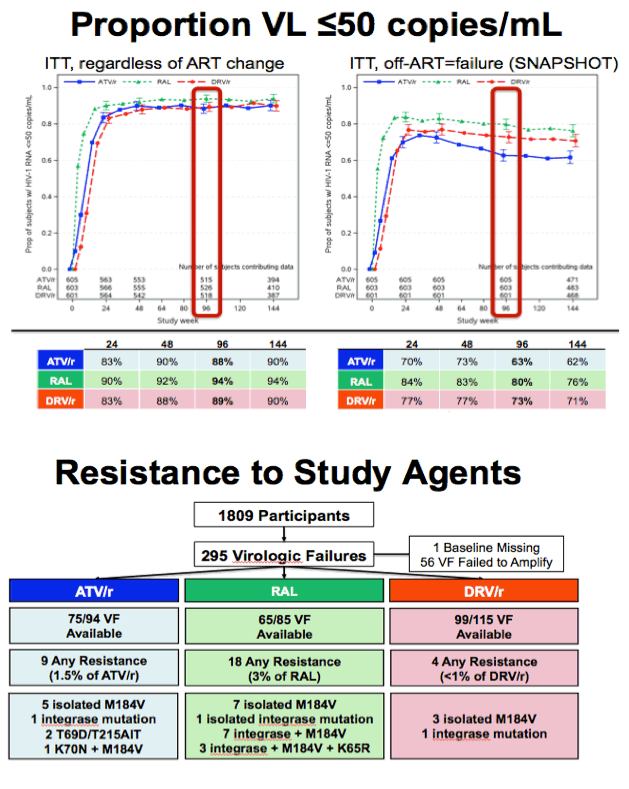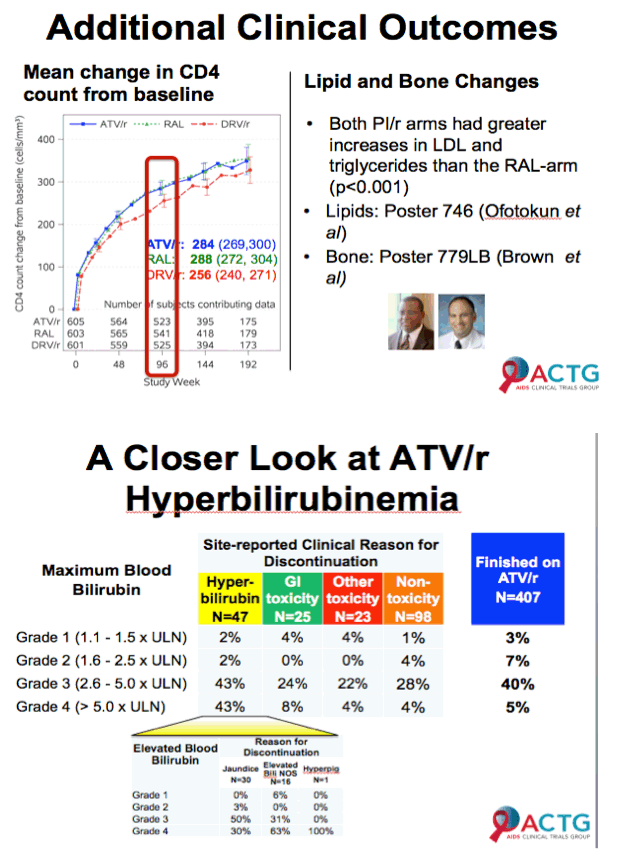 |
 |
 |
| |
Efficacy and Tolerability of Atazanavir, Raltegravir, or Darunavir
with FTC/TDF: ACTG A5257
|
| |
| |
- see full slide presentation below following report
CROI 2014, March 3-6, 2014, Boston
Mark Mascolini
Ninety-six weeks after randomization in ACTG 5257, first-line raltegravir proved superior to atazanavir/ritonavir or darunavir/ritonavir (all taken with tenofovir/emtricitabine) in an endpoint combining virologic efficacy and safety [1]. Atazanavir was inferior to raltegravir and darunavir in a tolerability endpoint, and darunavir was superior to atazanavir in the combined efficacy/safety endpoint.
ACTG 5257 aimed to compare the efficacy and safety of three nonnucleoside-sparing regimens in US antiretroviral-naive adults with a viral load above 1000 copies. Researchers randomized nearly 2000 people to standard doses of the three antiretrovirals, each with tenofovir/emtricitabine. The investigators followed participants until the last person reached week 96 week.
The trial had three endpoints: time to virologic failure, defined as time from entry to a confirmed viral load above 1000 copies from week 16 to before week 24 or above 200 copies at or after week 24; time to tolerability failure, defined as time from entry to discontinuation of one of the three major study drugs for toxicity; and a combined virologic/tolerability endpoint. The trial had 90% power to demonstrate equivalence in any pairwise (arm-versus-arm) comparison. Equivalence meant a 97.5% confidence interval (CI) entirely within +/- 10% in the pairwise difference in 96-week cumulative incidence.
This analysis involved 1809 eligible participants, 42% of them non-Hispanic black, 34% non-Hispanic white, 22% Hispanic, and 24% women. Median pretreatment viral load stood at 4.6 log10 copies/mL (about 40,000 copies), and 70% of participants had a pretreatment load below 100,000 copies. Median pretreatment CD4 count was 308, and 30% of enrollees had a pretreatment count below 200. None of these baseline variables differed much from one arm to another. More than 90% of participants in each arm completed 96 weeks of study.
Atazanavir, raltegravir, and darunavir proved equivalent in time to virologic failure at week 96. Cumulative incidence of virologic failure at 96 weeks was 13% with atazanavir, 10% with raltegravir, and 15% with darunavir. Intention-to-treat analysis ignoring antiretroviral changes determined that 88% assigned to atazanavir, 94% assigned to raltegravir, and 89% assigned to darunavir had a week-96 viral load below 50 copies. A snapshot analysis in which discontinuation meant failure registered 96-week sub-50-copy rates of 63% with atazanavir, 80% with raltegravir, and 73% with darunavir.
Among people with virologic failure, 9 of 75 atazanavir isolates sampled (12%) had any detectable resistance mutation, as did 18 of 65 raltegravir isolates (28%), and 4 of 99 darunavir isolates (4%). Proportions of people assigned to each drug who had virologic failure with resistance were 2.8% for atazanavir, 3.3% for raltegravir, and 2.0% for darunavir.
Tolerability failure was more frequent with atazanavir (14%) than with raltegravir (1%) or darunavir (5%), mainly because of clinical jaundice and hyperbilirubinemia with atazanavir. Statistical analysis indicated raltegravir was superior to atazanavir in time to tolerability failure (difference 13%, 95% CI 9.4% to 16%). Darunavir was also superior to atazanavir in time to tolerability failure (difference 9.2%, 95% CI 5.5% to 13%). Discontinuations for toxicity occurred in 16% assigned to atazanavir, 5% assigned to darunavir, and 1% assigned to raltegravir. Forty-seven of the 95 atazanavir toxicity discontinuations (49%) were attributed to jaundice or hyperbilirubinemia and 25 (26%) to gastrointestinal toxicity. GI problems accounted for 14 of 32 darunavir toxicity discontinuations (44%). Only 2 people assigned to raltegravir had GI trouble.
For the combined virologic failure/tolerability endpoint, raltegravir was superior to atazanavir (difference 15%, 95% CI 10% to 20%) and to darunavir (difference 7.5%, 95% CI 3.2% to 12%), and darunavir was superior to atazanavir (difference 7.5%, 95% CI 2.3% to 13%). ACTG investigators noted that virologic differences and toxicity largely explained the superiority of raltegravir to darunavir in this analysis.
The ACTG team concluded that raltegravir proved superior to both protease inhibitors for the combined virologic/tolerability endpoint, and darunavir proved superior to atazanavir for this endpoint. The clinical import of these findings is not as easily summarized. Raltegravir clearly emerged as a potent drug with minimal side effects in previously untreated people. Atazanavir suffered in the comparison because of well-appreciated and easily reversed problems like jaundice and high bilirubin, which the investigators made a point of calling "cosmetic hyperbilirubinemia."
Clinician/researcher Jose Arribas observed after the presentation that a narrower equivalence range might have been preferable in the statistical analysis. ACTG presenter Raphael Landovitz did not dismiss that point but observed that previous ACTG research suggested this statistical approach is most appropriate for trials like this.
Reference
1. Landovitz RL, Ribaudo HJ, Ofotokun I, et al. Efficacy and Tolerability of Atazanavir, Raltegravir, or Darunavir With FTC/Tenofovir: ACTG 5257. CROI 2014. Conference on Retroviruses and Opportunistic Infections. March 3-6, 2014. Boston. Abstract 85.
n. Abstract 85.
CROI webcast:
http://www.croiwebcasts.org/console/player/22172?mediaType=slideVideo&









|
| |
|
 |
 |
|
|